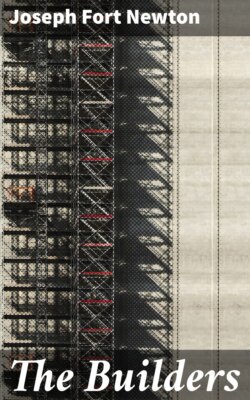Читать книгу The Builders - Joseph Fort Newton - Страница 14
На сайте Литреса книга снята с продажи.
ОглавлениеA Master Mason, in teaching apprentices, makes use of the compasses and the square. Ye who are engaged in the pursuit of wisdom must also make use of the compass and square.[21]
There are even evidences, in the earliest historic records of China, of the existence of a system of faith expressed in allegoric form, and illustrated by the symbols of building. The secrets of this faith seem to have been orally transmitted, the leaders alone pretending to have full knowledge of them. Oddly enough, it seems to have gathered about a symbolical temple put up in the desert, that the various officers of the faith were distinguished by symbolic jewels, and that at its rites they wore leather aprons.[22] From such records as we have it is not possible to say whether the builders themselves used their tools as emblems, or whether it was the thinkers who first used them to teach moral truths. In any case, they were understood; and the point here is that, thus early, the tools of the builder were teachers of wise and good and beautiful truth. Indeed, we need not go outside the Bible to find both the materials and working tools of the Mason so employed:[23]
For every house is builded by some man; but the builder of all things is God … whose house we are.[24]
Behold, I lay in Zion for a foundation a tried stone, a precious corner-stone, a sure foundation.[25]
The stone which the builders rejected is become the head of the corner.[26]
Ye also, as living stones, are built up into a spiritual house.[27]
When he established the heavens I was there, when he set the compass upon the face of the deep, when he marked out the foundations of the earth: then was I by him as a master workman.[28]
The Lord stood upon a wall made by a plumbline, with a plumbline in his hand. And the Lord said unto me, Amos, what seest thou? And I said, A plumbline. Then said the Lord, Behold, I will set a plumbline in the midst of my people Israel: I will not again pass by them any more.[29]
Ye shall offer the holy oblation foursquare, with the possession of the city.[30]
And the city lieth foursquare, and the length is as large as the breadth.[31]
Him that overcometh I will make a pillar in the temple of my God; and I will write upon him my new name.[32]
For we know that when our earthly house of this tabernacle is dissolved, we have a building of God, an house not made with hands, eternal in the heavens.[33]
If further proof were needed, it has been preserved for us in the imperishable stones of Egypt.[34] The famous obelisk, known as Cleopatra's Needle, now in Central Park, New York, the gift to our nation from Ismail, Khedive of Egypt in 1878, is a mute but eloquent witness of the antiquity of the simple symbols of the Mason. Originally it stood as one of the forest of obelisks surrounding the great temple of the Sun-god at Heliopolis, so long a seat of Egyptian learning and religion, dating back, it is thought, to the fifteenth century before Christ. It was removed to Alexandria and re-erected by a Roman architect and engineer named Pontius, B.C. 22. When it was taken down in 1879 to be brought to America, all the emblems of the builders were found in the foundation. The rough Cube and the polished Cube in pure white limestone, the Square cut in syenite, an iron Trowel, a lead Plummet, the arc of a Circle, the serpent-symbols of Wisdom, a stone Trestle-board, a stone bearing the Master's Mark, and a hieroglyphic word meaning Temple—all so placed and preserved as to show, beyond doubt, that they had high symbolic meaning. Whether they were in the original foundation, or were placed there when the obelisk was removed, no one can tell. Nevertheless, they were there, concrete witnesses of the fact that the builders worked in the light of a mystical faith, of which they were emblems.
Much has been written of buildings, their origin, age, and architecture, but of the builders hardly a word—so quickly is the worker forgotten, save as he lives in his work. Though we have no records other than these emblems, it is an obvious inference that there were orders of builders even in those early ages, to whom these symbols were sacred; and this inference is the more plausible when we remember the importance of the builder both to religion and the state. What though the builders have fallen into dust, to which all things mortal decline, they still hold out their symbols for us to read, speaking their thoughts in a language easy to understand. Across the piled-up debris of ages they whisper the old familiar truths, and it will be a part of this study to trace those symbols through the centuries, showing that they have always had the same high meanings. They bear witness not only to the unity of the human mind, but to the existence of a common system of truth veiled in allegory and taught in symbols. As such, they are prophecies of Masonry as we know it, whose genius it is to take what is old, simple, and universal, and use it to bring men together and make them friends.
Shore calls to shore
That the line is unbroken!
